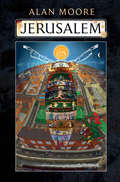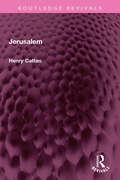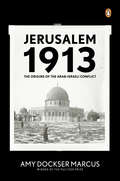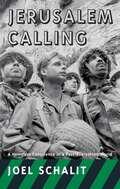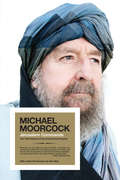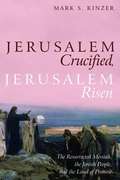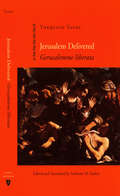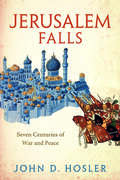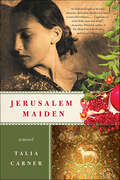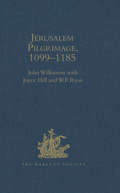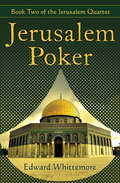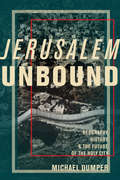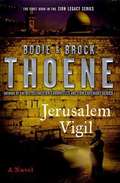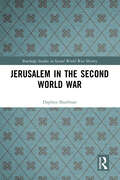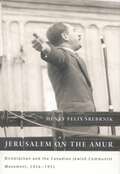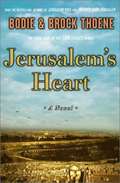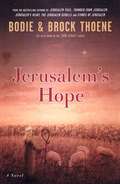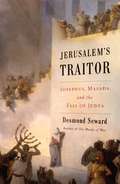- Table View
- List View
Jerusalem
by Alan MooreFierce in its imagining and stupefying in its scope, Jerusalem is the tale of everything, told from a vanished gutter. In the epic novel Jerusalem, Alan Moore channels both the ecstatic visions of William Blake and the theoretical physics of Albert Einstein through the hardscrabble streets and alleys of his hometown of Northampton, UK. In the half a square mile of decay and demolition that was England's Saxon capital, eternity is loitering between the firetrap housing projects. Embedded in the grubby amber of the district's narrative among its saints, kings, prostitutes, and derelicts, a different kind of human time is happening, a soiled simultaneity that does not differentiate between the petrol-colored puddles and the fractured dreams of those who navigate them. Employing, a kaleidoscope of literary forms and styles that ranges from brutal social realism to extravagant children's fantasy, from the modern stage drama to the extremes of science fiction, Jerusalem's dizzyingly rich cast of characters includes the living, the dead, the celestial, and the infernal in an intricately woven tapestry that presents a vision of an absolute and timeless human reality in all of its exquisite, comical, and heartbreaking splendor. In these pages lurk demons from the second-century Book of Tobit and angels with golden blood who reduce fate to a snooker tournament. Vagrants, prostitutes, and ghosts rub shoulders with Oliver Cromwell, Samuel Beckett, James Joyce's tragic daughter Lucia, and Buffalo Bill, among many others. There is a conversation in the thunderstruck dome of St. Paul's Cathedral, childbirth on the cobblestones of Lambeth Walk, an estranged couple sitting all night on the cold steps of a Gothic church front, and an infant choking on a cough drop for eleven chapters. An art exhibition is in preparation, and above the world a naked old man and a beautiful dead baby race along the Attics of the Breath toward the heat death of the universe. An opulent mythology for those without a pot to piss in, through the labyrinthine streets and pages of Jerusalem tread ghosts that sing of wealth, poverty, and our threadbare millennium. They discuss English as a visionary language from John Bunyan to James Joyce, hold forth on the illusion of mortality post-Einstein, and insist upon the meanest slum as Blake's eternal holy city.
Jerusalem (Routledge Revivals)
by Henry CattanFirst published in 1981, Jerusalem provides an overview of the history of Jerusalem and its crucial linkage with the peace and stability in the Middle East. Jerusalem is unique amongst all the cities of the world because of its association with three great religions. It is the spiritual and religious heritage to one half of humanity and is holy for millions of Christians, Jews, and Muslims. All three religion have a vital interest in preserving in addition to their Holy places and sanctuaries, the living presence of the adherents to their faith in the Holy City. When the Zionist movement was formed at the end of the last century, the idea of a Jewish State was conceived as an answer to anti-semitism, and the movement initially considered other countries for settlement because Jerusalem was seen as a spiritual rather than a secular home to the Jewish people. Yet since the creation of the state of Israel in 1948, Zionism has claimed Jerusalem as its own. It is obvious that neither the Palestinians, not the Arabs, nor Islam and Christianity will acquiesce in Israeli domination. This book argues that the continuation of Zionism in its present form is likely to prove perilous to peace and stability in the region. This book is an important historical read for students and scholars of Middle East studies and Middle East history.
Jerusalem 1900: The Holy City in the Age of Possibilities
by Catherine Tihanyi Lys Ann Weiss Vincent LemirePerhaps the most contested patch of earth in the world, Jerusalem’s Old City experiences consistent violent unrest between Israeli and Palestinian residents, with seemingly no end in sight. Today, Jerusalem’s endless cycle of riots and arrests appears intractable—even unavoidable—and it looks unlikely that harmony will ever be achieved in the city. But with Jerusalem 1900, historian Vincent Lemire shows us that it wasn’t always that way, undoing the familiar notion of Jerusalem as a lost cause and revealing a unique moment in history when a more peaceful future seemed possible. In this masterly history, Lemire uses newly opened archives to explore how Jerusalem’s elite residents of differing faiths cooperated through an intercommunity municipal council they created in the mid-1860s to administer the affairs of all inhabitants and improve their shared city. These residents embraced a spirit of modern urbanism and cultivated a civic identity that transcended religion and reflected the relatively secular and cosmopolitan way of life of Jerusalem at the time. These few years would turn out to be a tipping point in the city’s history—a pivotal moment when the horizon of possibility was still open, before the council broke up in 1934, under British rule, into separate Jewish and Arab factions. Uncovering this often overlooked diplomatic period, Lemire reveals that the struggle over Jerusalem was not historically inevitable—and therefore is not necessarily intractable. Jerusalem 1900 sheds light on how the Holy City once functioned peacefully and illustrates how it might one day do so again.
Jerusalem 1913
by Marcus Amy DockserSearching for the origins of the Arab-Israeli conflict, historians for years focused on the British Mandate period (1920-1948). Amy Dockser Marcus, however, demonstrates that the bloody struggle for power actually started much earlier, when Jerusalem was still part of the Ottoman Empire and the rise of Zionism and Arab nationalism laid the groundwork for the battles that would continue to rage nearly a century later.
Jerusalem Afflicted: Quaresmius, Spain, and the Idea of a 17th-century Crusade
by Chad Leahy Ken TullyOn Good Friday, 1626, Franciscus Quaresmius delivered a sermon in the Church of the Holy Sepulcher in Jerusalem calling on King Philip IV of Spain to undertake a crusade to ‘liberate’ the Holy Land. Jerusalem Afflicted: Quaresmius, Spain, and the Idea of a 17th-century Crusade introduces readers to this unique call to arms with the first-ever edition of the work since its publication in 1631. Aside from an annotated English translation of the sermon, this book also includes a series of introductory chapters providing historical context and textual commentary, followed by an anthology of Spanish crusading texts that testify to the persistence of the idea of crusade throughout the 17th century. Quaresmius’ impassioned and thoroughly reasoned plea is expressed through the voice of Jerusalem herself, personified as a woman in bondage. The friar draws on many of the same rhetorical traditions and theological assumptions that first launched the crusading movement at Clermont in 1095, while also bending those traditions to meet the unique concerns of 17th-century geopolitics in Europe and the Mediterranean. Quaresmius depicts the rescue of the Holy City from Turkish abuse as a just and necessary cause. Perhaps more unexpectedly, he also presents Jerusalem as sovereign Spanish territory, boldly calling on Philip as King of Jerusalem and Patron of the Holy Places to embrace his royal duty and reclaim what is rightly his on behalf of the universal faithful. Quaresmius’ early modern call to crusade ultimately helps us rethink the popular assumption that, like the chivalry imagined by Don Quixote, the crusades somehow died along with the middle ages.
Jerusalem Besieged: From Ancient Canaan to Modern Israel
by Eric H. Cline"Jerusalem Besieged is a fascinating account of how and why a baffling array of peoples, ideologies, and religions have fought for some four thousand years over a city without either great wealth, size, or strategic importance. Cline guides us through the baffling, but always bloody, array of Jewish, Roman, Moslem, Crusader, Ottoman, Western, Arab, and Israeli fights for possession of such a symbolic prize in a manner that is both scholarly and engaging. " -Victor Davis Hanson, Stanford University; author ofThe Other GreeksandCarnage and Culture "A beautifully lucid presentation of four thousand years of history in a single volume. Cline writes primarily as an archaeologist-avoiding polemic and offering evidence for any religious claims-yet he has also incorporated much journalistic material into this study. Jerusalem Besieged will enlighten anyone interested in the history of military conflict in and around Jerusalem. " -Col. Rose Mary Sheldon, Virginia Military Institute "This groundbreaking study offers a fascinating synthesis of Jerusalem's military history from its first occupation into the modern era. Cline amply deploys primary source material to investigate assaults on Jerusalem of every sort, starting at the dawn of recorded history. Jerusalem Besieged is invaluable for framing the contemporary situation in the Middle East in the context of a very long and pertinent history. " -Baruch Halpern, Pennsylvania State University A sweeping history of four thousand years of struggle for control of one city "[An] absorbing account of archaeological history, from the ancient Israelites' first conquest to today's second intifada. Cline clearly lays out the fascinating history behind the conflicts. " -USA Today "A pleasure to read, this work makes this important but complicated subject fascinating. " -Jewish Book World "Jerusalem Besieged is a fascinating account of how and why a baffling array of peoples, ideologies, and religions have fought for some four thousand years over a city without either great wealth, size, or strategic importance. Cline guides us through the baffling, but always bloody, array of Jewish, Roman, Moslem, Crusader, Ottoman, Western, Arab, and Israeli fights for possession of such a symbolic prize in a manner that is both scholarly and engaging. " -Victor Davis Hanson, Stanford University; author of The Other Greeks and Carnage and Culture
Jerusalem Calling: A Homeless Conscience In A Post-everything World
by Joel SchalitJerusalem Calling marks the emergence of a new breed of public intellectual. American by birth, Israeli by association, and homeless by conscience, Joel Schalit is uniquely qualified to blast all stereotypes of Jewish identity. Moving effortlessly from philosophical complexity to outrageous humor, Schalit’s writing, and his ability to critically interrogate everything from the religious right to punk rock to Middle Eastern politics provides a singular perspective on life in a post-everything age. This book signals the emergence of a new breed of public intellectual. Joel Schalit is a political scientist living in San Francisco, where he works as an editor of Chicago's Punk Planet magazine and UC Berkeley's online politics and culture journal, Bad Subjects. He is a regular contributor to the San Francisco Bay Guardian. Schalit co-edited and contributed to Bad Subjects: Political Education for Everyday Life (NYU Press, 1998).
Jerusalem Commands: The Third Volume of the Colonel Pyat Quartet
by Michael Moorcock Alan WallBack in print for the first time in 30 years, this epic and hilariously comic adventure follows the fictional Colonel Pyat through real historical settings as he fumbles and forces his way through life as an antihero everyman, leaving a trail of wreckage as he passes through some of the most chilling moments of the 20th century. This thrilling third installment of the Pyat quartet sees Pyat hitchhiking across the United States, acting in Hollywood, and avoiding perverts in Cairo. As Pyat schemes and fantasizes his way from cult success to sexual degradation, he pulls strength from his wild dreams and profligate inventions. Nazi, addict, and rebel, Pyat weaves a complicated tapestry of lies and deceit, wherein the reader discovers that this wild farce becomes a lens for focusing universal and uncomfortable truths about society and man.
Jerusalem Crucified, Jerusalem Risen: The Resurrected Messiah, the Jewish People, and the Land of Promise
by Mark Kinzerhe good news (euangelion) of the crucified and risen Messiah was proclaimed first to Jews in Jerusalem, and then to Jews throughout the land of Israel. In Jerusalem Crucified, Jerusalem Risen, Mark Kinzer argues that this initial audience and geographical setting of the euangelion is integral to the eschatological content of the message itself. While the good news is universal in concern and cosmic in scope, it never loses its particular connection to the Jewish people, the city of Jerusalem, and the land of Israel. The crucified Messiah participates in the future exilic suffering of his people, and by his resurrection offers a pledge of Jerusalem's coming redemption. Basing his argument on a reading of the Acts of the Apostles and the Gospel of Luke, Kinzer proposes that the biblical message requires its interpreters to reflect theologically on the events of post-biblical history. In this context he considers the early emergence of Rabbinic Judaism and the much later phenomenon of Zionism, offering a theological perspective on these historical developments that is biblically-rooted, attentive to both Jewish and Christian tradition, and minimalist in the theological constraints it imposes on the just resolution of political conflict in the Middle East." Kinzer also briefly discusses Messianic Judaism in terms of its relationship to Zionism and to his overarching thesis stated above. While his foundational texts are Luke and Acts, he also supports his arguments by analyzing other biblical texts and non-biblical sources in his main text and in his extensive footnotes.
Jerusalem Delivered (Gerusalemme liberata): Gerusalemme Liberata
by Torquato TassoLate in the eleventh century the First Crusade culminated in the conquest of Jerusalem by Christian armies. Five centuries later, when Torquato Tasso began to search for a subject worthy of an epic, Jerusalem was governed by a sultan, Europe was in the crisis of religious division, and the Crusades were a nostalgic memory. Tasso turned to the First Crusade both as a subject that would test his poetic ambition and as a reflection on the quandaries of his own time. He sought to create a masterpiece that would deserve comparison with the great epics of the past.Gerusalemme liberata became one of the most widely read and cherished books of the Renaissance. First published in 1581, it was translated into English by Edward Fairfax in 1600. That translation has been the standard, even though Fairfax was only a good, not a great, poet. Fairfax tried to fit Tasso's verse into Spenserian stanzas, adding to and subtracting from the original and often changing Tasso's meaning.Anthony Esolen's new translation captures the delight of Tasso's descriptions, the different voices of its cast of characters, the shadings between glory and tragedy—and it does all this in an English as powerful and clear as Tasso's Italian. Tasso's masterpiece finally emerges as an English masterpiece.
Jerusalem Delivered: An English Prose Version
by Torquato Tasso Ralph NashRalph Nash, in his approach to Gerusalemme Liberata, concluded that a close, fluent translation in prose of Tasso's epic would offer the most successful rendering of this important chivalric romance.
Jerusalem Falls: Seven Centuries of War and Peace
by John D. HoslerThe first full account of the medieval struggle for Jerusalem, from the seventh to the thirteenth century The history of Jerusalem is one of conflict, faith, and empire. Few cities have been attacked as often and as savagely. This was no less true in the Middle Ages. From the Persian sack in 614 through the bloody First Crusade and beyond, Jerusalem changed hands countless times. But despite these horrific acts of violence, its story during this period is also one of interfaith tolerance and accord. In this gripping history, John D. Hosler explores the great clashes and delicate settlements of medieval Jerusalem. He examines the city&’s many sieges and considers the experiences of its inhabitants of all faiths. The city&’s conquerors consistently acknowledged and reinforced the rights of those religious minorities over which they ruled. Deeply researched, this account reveals the way in which Jerusalem&’s past has been constructed on partial histories—and urges us to reckon with the city&’s broader historical contours.
Jerusalem Maiden: A Novel
by Talia Carner“Talia Carner is a skillful and heartfelt storyteller who takes the reader on journey of the senses, into a world long forgotten.”—Jennifer Lauck, author of Blackbird“Exquisitely told, with details so vivid you can almost taste the food and hear the voices….A moving and utterly captivating novel that I will be thinking about for a long, long time.”—Tess Gerritsen, author of The Silent Girl“Talia Carner’s story captivates at every level, heart and mind.”—Jacquelyn Mitchard, author of The Deep End of the OceanThe poignant, colorful, and unforgettable story of a young woman in early 20th-century Jerusalem who must choose between her faith and her passion, Jerusalem Maiden heralds the arrival of a magnificent new literary voice, Talia Carner. In the bestselling vein of The Red Tent, The Kite Runner, and A Thousand Splendid Suns, Jerusalem Maiden brilliantly evokes the sights and sounds of the Middle East during the final days of the Ottoman Empire. Historical fiction and Bible lovers will be captivated by this thrilling tale of a young Jewish woman during a fascinating era, her inner struggle with breaking the Second Commandment, and her ultimate transcendence through self-discovery.
Jerusalem Pilgrimage, 1099–1185 (Hakluyt Society, Second Series)
by John Wilkinson Joyce HillIn the Latin Kingdom of Jerusalem many pilgrims came to Jerusalem. The translations in this book are of seventeen western accounts of pilgrimage, written between 1099 and 1185, and there are two additional accounts from eastern pilgrims, Abbot Daniel from Russia and John Phocas from Antioch. As a whole this collection shows the gradually developing way in which western Christians understood the Holy Places. Some early pilgrims depended on authorities, many of whom by 1099 were out-of-date. They tried to deliver the truth about the Holy Places and to be reticent about their own reactions. But the pilgrims who appear later in the collections made their own archaeological judgements, and were more free about their own reactions. Pilgrimage after 1099 was altered by the fact that by their victory over Jerusalem the Dome of the Rock fell into the Crusader's hands. Otherwise the differences of practice between eastern and western pilgrims were slight. Thus eastern pilgrims visited the Greek and western pilgrims the Latin monasteries. Western pilgrims had a different idea of the location of Emmaus, and before 1185 a western Way of the Cross was beginning to take shape. These were slight differences, and in general all Christian pilgrims, whether from east or west, visited the same Holy Places as they had during the preceding period. Most of the works in this collection were translated into English a century ago by the Palestine Pilgrim's Text Society. But these texts were produced separately as pamphlets, and lacked a general introduction. In this book therefore the texts are retranslated, sometimes from more accurate texts. In introducing the texts some valuable new evidence from archaeology has been used and enabled a new assessment of their dates.
Jerusalem Poker: Sinai Tapestry, Jerusalem Poker, Nile Shadows, And Jericho Mosaic (The Jerusalem Quartet #2)
by Edward WhittemoreThe second book of the Jerusalem Quartet, in which the fate of the Holy City is determined by an epic poker game played in the back of a Jerusalem antiques shop On New Year&’s Eve, 1921, three men sit down to a poker game. The Great Jerusalem Poker Game, as it&’s eventually known, continues for the next twelve years—the players unwilling to leave a competition whose prize is control of Jerusalem. The players are as exotic as the game: Cairo Martyr, a one-time African slave, now the Middle East&’s chief supplier of aphrodisiac mummy dust; Joe O&’Sullivan Beare, an Irish tradesman with a specialty in sacred phallic amulets; and Munk Szondi, an Austro-Hungarian Imperial Army colonel turned dedicated Zionist.But before the final hand is played to determine the destiny of the Holy City, a dangerous new player enters the picture: Nubar Wallenstein, an Albanian alchemist determined to achieve immortality, and heir to the world&’s largest oil syndicate. He finances a vast network of spies dedicated to destroying the players, and his aim is to win complete power over Jerusalem.Jerusalem Poker is the second volume of the Jerusalem Quartet, which begins with Sinai Tapestry and continues with Nile Shadows and Jericho Mosaic.
Jerusalem Unbound
by Michael DumperJerusalem's formal political borders reveal neither the dynamics of power in the city nor the underlying factors that make an agreement between Israel and the Palestinians so difficult. The lines delineating Israeli authority are frequently different from those delineating segregated housing or areas of uneven service provision or parallel national electoral districts of competing educational jurisdictions. In particular, the city's large number of holy sites and restricted religious compounds create enclaves that continually threaten to undermine the Israeli state's authority and control over the city. This lack of congruity between political control and the actual spatial organization and everyday use of the city leaves many areas of occupied East Jerusalem in a kind of twilight zone where citizenship, property rights, and the enforcement of the rule of law are ambiguously applied.Michael Dumper plots a history of Jerusalem that examines this intersecting and multileveled matrix and in so doing is able to portray the constraints on Israeli control over the city and the resilience of Palestinian enclaves after forty-five years of Israeli occupation. Adding to this complex mix is the role of numerous external influences -- religious, political, financial, and cultural -- so that the city is also a crucible for broader contestation. While the Palestinians may not return to their previous preeminence in the city, neither will Israel be able to assert a total and irreversible dominance. His conclusion is that the city will not only have to be shared, but that the sharing will be based upon these many borders and the interplay between history, geography, and religion.
Jerusalem Unbound
by Michael DumperJerusalem's formal political borders reveal neither the dynamics of power in the city nor the underlying factors that make an agreement between Israel and the Palestinians so difficult. The lines delineating Israeli authority are frequently different from those delineating segregated housing or areas of uneven service provision or parallel national electoral districts of competing educational jurisdictions. In particular, the city's large number of holy sites and restricted religious compounds create enclaves that continually threaten to undermine the Israeli state's authority and control over the city. This lack of congruity between political control and the actual spatial organization and everyday use of the city leaves many areas of occupied East Jerusalem in a kind of twilight zone where citizenship, property rights, and the enforcement of the rule of law are ambiguously applied.Michael Dumper plots a history of Jerusalem that examines this intersecting and multileveled matrix and in so doing is able to portray the constraints on Israeli control over the city and the resilience of Palestinian enclaves after forty-five years of Israeli occupation. Adding to this complex mix is the role of numerous external influences -- religious, political, financial, and cultural -- so that the city is also a crucible for broader contestation. While the Palestinians may not return to their previous preeminence in the city, neither will Israel be able to assert a total and irreversible dominance. His conclusion is that the city will not only have to be shared, but that the sharing will be based upon these many borders and the interplay between history, geography, and religion.
Jerusalem Unbound: Geography, History, and the Future of the Holy City
by Michael DumperJerusalem's formal political borders reveal neither the dynamics of power in the city nor the underlying factors that make an agreement between Israel and the Palestinians so difficult. The lines delineating Israeli authority are frequently different from those delineating segregated housing or areas of uneven service provision or parallel national electoral districts of competing educational jurisdictions. In particular, the city's large number of holy sites and restricted religious compounds create enclaves that continually threaten to undermine the Israeli state's authority and control over the city. This lack of congruity between political control and the actual spatial organization and everyday use of the city leaves many areas of occupied East Jerusalem in a kind of twilight zone where citizenship, property rights, and the enforcement of the rule of law are ambiguously applied.Michael Dumper plots a history of Jerusalem that examines this intersecting and multileveled matrix and, in so doing, is able to portray the constraints on Israeli control over the city and the resilience of Palestinian enclaves after forty-five years of Israeli occupation. Adding to this complex mix is the role of numerous external influences—religious, political, financial, and cultural—so that the city is also a crucible for broader contestation. While the Palestinians may not return to their previous preeminence in the city, neither will Israel be able to assert a total and irreversible dominance. His conclusion is that the city will not only have to be shared but that the sharing will be based upon these many borders and the interplay between history, geography, and religion.
Jerusalem Vigil (The Zion Legacy Book #1)
by Bodie Thoene Brock ThoeneThe year is 1948. Jewish and Muslim forces battle each other for the Holy City they are all willing to die for. Because this is a book about war, readers should be prepared for gruesome descriptions of violence in some parts of this historical fiction novel.
Jerusalem in the Second World War (Routledge Studies in Second World War History)
by Daphna SharfmanThis book is the first to present the unique story of the city of Jerusalem during the events of the Second World War and how it played a unique role in both the military and civilian aspects of the war. Whilst Jerusalem is usually known for topics such as religion, archaeology, or the politics of the Israeli–Arab conflict, this volume provides an in-depth analysis of this exceptional and temporary situation in Jerusalem, offering a perspective that is different from the usual political-strategic-military analysis. Although battles were raging in the nearby countries of Syria and Lebanon, and the war in Egypt and the Western Desert, the people who came to Jerusalem, as well as those who lived there, had different agendas and perspectives. Some were spies and intelligence officers, other were exiles or refugee immigrants from Europe who managed at the last moment to escape Nazi persecution. Journalists and writers described life in the city at this time. All were probably conscious of the fact that when the war came to an end, local rivalry and mounting conflict would take the centre stage again. This was a time of a special, magical drawn-out moment that may shed light on an alternative, more peaceful, kind of Jerusalem that unfortunately was not to be. This volume seeks to find an alternative approach and to contribute to the development of insightful research into life in an unordinary city in an unordinary situation. It will be of value to those interested in military history and the history of the Middle East.
Jerusalem on the Amur: Birobidzhan and the Canadian Jewish Communist Movement, 1924-1951 (McGill-Queen's Studies in Ethnic History #225)
by Henry Felix SrebrnikThe Canadian Jewish Communist movement, an influential ideological voice within the Canadian left, played a major role in the politics of Jewish communities in cities such as Montreal, Toronto, and Winnipeg, as well as many smaller centres, between the 1920s and the 1950s. Jerusalem on the Amur looks at the interlocking group of left-wing Jewish organizations that shared the political views of the Canadian Communist Party and were vocal proponents of policies perceived as beneficial to the Jewish working class. Focusing on the Association for Jewish Colonization in Russia, known by its transliterated acronym as the ICOR, and the Canadian Ambijan Committee, Henry Srebrnik uses Yiddish-language books, newspapers, pamphlets, and other materials to trace the ideological and material support provided by the Canadian Jewish Communist movement to Birobidzhan.
Jerusalem's Heart (The Zion Legacy Book #3)
by Bodie Thoene Brock ThoeneIt is May 23, 1948, in the maelstrom of the conflict between Jewish and Muslim forces. Nine days of brutal fighting have passed since the new State of Israel was proclaimed, the Zion Gate is closed, and supplies for the patriots are quickly running out. Inside the city, the spirit of the valiant defenders threatens to fail. Moshe Sachar is trapped in enemy territory and races desperately to reach those still fighting for the Old City, including his pregnant wife, Rachel. Her grandfather sees a prophecy of hope for Jerusalem, but can Moshe reach them before the attacks overtake them and it is too late?
Jerusalem's Hope
by Brock ThoeneIn this bestselling series Bodie and Brock Thoene have thrilled readers with an epic tale chronicling the struggle for the world's holiest and most turbulent city. As Jerusalem's Hope opens, strategist Moshe Sachar remains hidden in a secret tunnel beneath the Temple Mount, safely removed from the chaos of Israel's 1948 war of independence, while the funeral of an elder rabbi proceeds above him. Using the instructions the rabbi gave him before his death, Moshe opens another sacred scroll and is once again transported to the dramatic biblical story of a charismatic but mysterious prophet. As word of the miracles performed by this seer spreads, bloody violence erupts, threatening the future of the Roman state and revealing the prophet's surprising identity. .
Jerusalem's Hope (The Zion Legacy Book #6)
by Bodie Thoene Brock ThoeneJerusalem's Hope, the final volume in the Zion Legacy series, continues the story-within-a-story of the Jerusalem Scrolls and Stones of Jerusalem. Israeli strategist Moshe Sachar has taken refuge in a secret tunnel, beneath the Temple Mount, from the battle chaos of the 1948 war of independence. Now, he opens another of the temple's ancient scrolls and plunges into the supreme drama of the first century A.D. As word spreads of the miracles performed by a charismatic but mysterious prophet, Yeshua, people whose lives he has touched are caught up in destiny. A Roman centurion--in love with a Hebrew beauty--is torn between admiration and duty. Three "sparrows," ragamuffin orphan boys in hiding with Yeshua, are his vital messengers to a shepherd in Bethlehem. As all these characters converge on the dangerous road to Jerusalem at Passover, Jerusalem's Hope delivers the timely and sweeping climax fans have been waiting for.
Jerusalem's Traitor: Josephus, Masada, and the Fall of Judea
by Desmond SewardFrom a leading historian, the life and works of Josephus in first-century Jerusalem, during the war against Rome, the siege of Masada, and early Christianity
